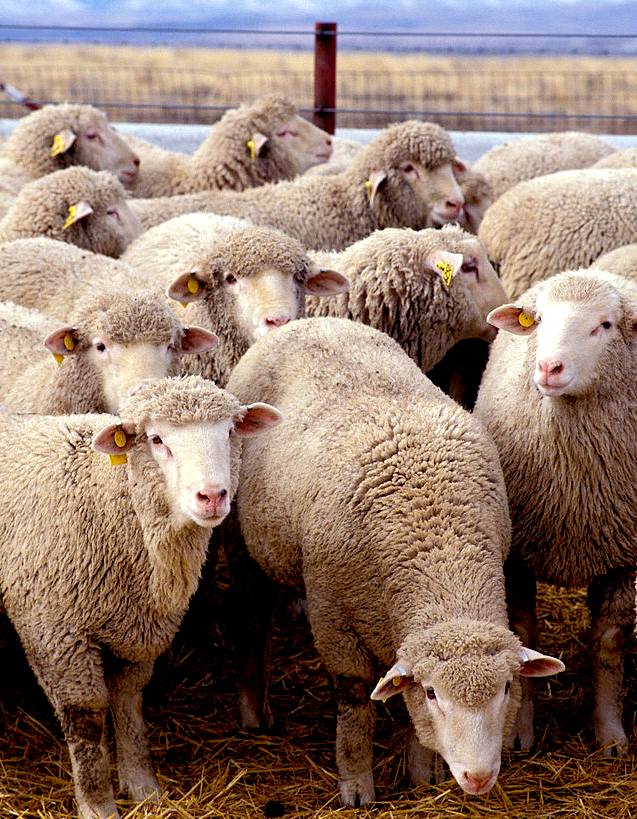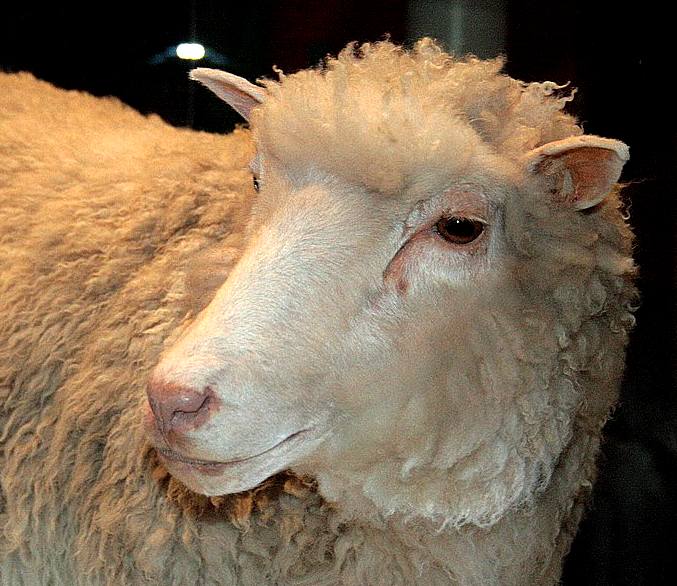|

A
flock of sheep, tagged and well fed. Sheep provide wool and meat for
humans and do not require shelters that other domestic animals must
have.
There
is nothing quite so uplifting as watching lambs playing together is a
grassy meadow in summertime. Their soft coats and inelegant antics
epitomize British agriculture - converting grass to protein - and they
taste good too. Indeed, sheep are farmed all over the world and seem to
adapt to heat and cold, not quite painting the same picture in England
as they might in arid slopes of Iran or India.
Sheep (Ovis aries) are quadrupedal, ruminant mammals typically kept as livestock. Like all ruminants, sheep are members of the order Artiodactyla, the even-toed ungulates. Although the name "sheep" applies to many species in the genus Ovis, in everyday usage it almost always refers to Ovis
aries.
Numbering a little over one billion, domestic sheep are also the most numerous species of sheep. An adult female sheep is referred to as a ewe, an intact male as a ram or occasionally a tup, a castrated male as a wether, and a younger sheep as a lamb.
Sheep are most likely descended from the wild mouflon of Europe and
Asia. One of the earliest animals to be domesticated for agricultural purposes, sheep are raised for fleece, meat (lamb, hogget or mutton) and milk. A sheep's wool is the most widely used animal fiber, and is usually harvested by shearing. Ovine meat is called lamb when from younger animals and mutton when from older ones. Sheep continue to be important for wool and meat today, and are also occasionally raised for pelts, as dairy animals, or as model organisms for science.
Sheep husbandry is practised throughout the majority of the inhabited world, and has been fundamental to many civilizations. In the modern era,
Australia, New
Zealand, the southern and central South American nations, and the British Isles are most closely associated with sheep production.
Sheepraising has a large lexicon of unique terms which vary considerably by region and dialect. Use of the word sheep began in Middle English as a derivation of the Old English word scēap; it is both the singular and plural name for the animal. A group of sheep is called a flock, herd or mob. Many other specific terms for the various life stages of sheep exist, generally related to lambing, shearing, and age.
Being a key animal in the history of farming, sheep have a deeply entrenched place in human culture, and find representation in much modern language and symbology. As livestock, sheep are most often associated with pastoral, Arcadian imagery. Sheep figure in many mythologies—such as the Golden Fleece—and major religions, especially the Abrahamic traditions. In both ancient and modern religious ritual, sheep are used as sacrificial animals.

Well,
hello Dolly. Haven't I seen you somewhere before? That's the trouble
with cloning, they all look alike. Is it cheaper to clone sheep or breed
them naturally. Dolly did not live very long and suffered many health
problems. It is likely that cloning science has a ways to go before we
can start thinking of taking it seriously. It is illegal to clone a
human at the moment. Apart from genetically engineering super humans, or
seeking to repair bodies to extend life, cloning is just a pipedream.
SHEEP
IN SCIENCE - CLONING
Sheep are generally too large and reproduce too slowly to make ideal research subjects, and thus are not a common model organism. They have, however, played an influential role in some fields of science. In particular, the Roslin Institute of Edinburgh,
Scotland used sheep for genetics research that produced groundbreaking results. In 1995, two ewes named Megan and Morag were the first mammals cloned from differentiated cells. A year later, a Finnish Dorset sheep named Dolly, dubbed "the world's most famous sheep" in Scientific American, was the first mammal to be cloned from an adult somatic cell. Following this, Polly and Molly were the first mammals to be simultaneously cloned and transgenic.
As of 2008, the sheep genome has not been fully sequenced, although a detailed genetic map has been published, and a draft version of the complete genome produced by assembling sheep
DNA sequences using information given by the genomes of other mammals. In 2012, a transgenic sheep named "Peng Peng" was cloned by Chinese scientists, who spliced his genes with that of a roundworm (C. elegans) in order to increase production of fats healthier for
human consumption.
In the study of natural selection, the population of Soay sheep that remain on the island of Hirta have been used to explore the relation of body size and coloration to reproductive success. Soay sheep come in several colors, and researchers investigated why the larger, darker sheep were in decline; this occurrence contradicted the rule of thumb that larger members of a population tend to be more successful reproductively. The feral Soays on Hirta are especially useful subjects because they are isolated.
Sheep are one of the few animals where the molecular basis of the diversity of male sexual preferences has been examined. However, this research has been controversial, and much publicity has been produced by a study at the Oregon Health and Science University that investigated the mechanisms that produce
homosexuality in rams. Organizations such as PETA campaigned against the study, accusing scientists of trying to cure homosexuality in the sheep. OHSU and the involved scientists vehemently denied such accusations.
Domestic sheep are sometimes used in medical research, particularly for researching cardiovascular physiology, in areas such as hypertension and heart failure. Pregnant sheep are also a useful model for human
pregnancy, and have been used to investigate the effects on fetal development of malnutrition and hypoxia. In behavioral sciences, sheep have been used in isolated cases for the study of facial recognition, as their mental process of recognition is qualitatively similar to humans.
SHEEP
AS FOOD
Sheep meat and milk were one of the earliest staple proteins consumed by human civilization after the transition from hunting and gathering to agriculture. Sheep meat prepared for food is known as either mutton or lamb. "Mutton" is derived from the Old French moton, which was the word for sheep used by the Anglo-Norman rulers of much of the British Isles in the Middle Ages. This became the name for sheep meat in English, while the Old English word sceap was kept for the live animal. Throughout modern history, "mutton" has been limited to the meat of mature sheep usually at least two years of age; "lamb" is used for that of immature sheep less than a year.
In the 21st century, the nations with the highest consumption of sheep meat are the Arab States of the Persian Gulf, New Zealand, Australia,
Greece, Uruguay, the United Kingdom and Ireland. These countries eat 14–40 lbs (3–18 kg) of sheep meat per capita, per annum. Sheep meat is also popular in France, Africa (especially the Maghreb), the Caribbean, the rest of the Middle East, India, and parts of China. This often reflects a history of sheep production. In these countries in particular, dishes comprising alternative cuts and offal may be popular or traditional. Sheep testicles
- called animelles or lamb fries - are considered a delicacy in many parts of the world. Perhaps the most unusual dish of sheep meat is the Scottish haggis, composed of various
sheep innards cooked along with oatmeal and chopped onions inside its stomach. In comparison, countries such as the U.S. consume only a pound or less (under 0.5 kg), with Americans eating 50 pounds (22 kg) of pork and 65 pounds (29 kg) of beef. In addition, such countries rarely eat mutton, and may favor the more expensive cuts of lamb: mostly lamb chops and leg of lamb.
Though sheep's milk may be drunk rarely in fresh form, today it is used predominantly in cheese and yogurt making. Sheep have only two teats, and produce a far smaller volume of milk than cows. However, as sheep's milk contains far more fat, solids, and minerals than cow's milk, it is ideal for the cheese-making process. It also resists contamination during cooling better because of its much higher calcium content Well-known cheeses made from sheep milk include the Feta of Bulgaria and Greece, Roquefort of France, Manchego from Spain, the Pecorino Romano (the
Italian word for sheep is pecore) and Ricotta of Italy. Yogurts, especially some forms of strained yogurt, may also be made from sheep milk. Many of these products are now often made with cow's milk, especially when produced outside their country of origin. Sheep milk contains 4.8% lactose, which may affect those who are intolerant.
As with other domestic animals, the meat of uncastrated males is inferior in quality, especially as they grow. A "bucky" lamb is a lamb which was not castrated early enough, or which was castrated improperly (resulting in one testicle being retained). These lambs are worth less at market.
SHEEP
IN THE WORLD ECONOMY
Sheep are an important part of the global agricultural
economy, probably with more sense than the average voter. However, their once vital status has been largely replaced by other livestock species, especially the pig, chicken, and cow.
China, Australia, India, and Iran have the largest modern flocks, and serve both local and exportation needs for wool and mutton. Other countries such as New Zealand have smaller flocks but retain a large international economic impact due to their export of sheep products. Sheep also play a major role in many local economies, which may be niche markets focused on organic or sustainable agriculture and local food customers. Especially in developing countries, such flocks may be a part of subsistence agriculture rather than a system of trade. Sheep themselves may be a medium of trade in barter economies.
Domestic sheep provide a wide array of raw materials. Wool was one of the first textiles, although in the late 20th century wool prices began to fall dramatically as the result of the popularity and cheap prices for synthetic fabrics. For many sheep owners, the cost of shearing is greater than the possible profit from the fleece, making subsisting on wool production alone practically impossible without farm subsidies. Fleeces are used as material in making alternative products such as wool insulation. In the 21st century, the sale of meat is the most profitable enterprise in the sheep industry, even though far less sheep meat is consumed than chicken, pork or beef.
Sheepskin is likewise used for making clothes, footwear, rugs, and other products. Byproducts from the slaughter of sheep are also of value: sheep tallow can be used in candle and soap making, sheep bone and cartilage has been used to furnish carved items such as dice and buttons as well as rendered glue and gelatin. Sheep intestine can be formed into sausage casings, and lamb intestine has been formed into surgical sutures, as well as strings for musical instruments and tennis rackets. Sheep droppings, which are high in cellulose, have even been sterilized and mixed with traditional pulp materials to make paper. Of all sheep byproducts, perhaps the most valuable is lanolin: the waterproof, fatty substance found naturally in sheep's wool and used as a base for innumerable cosmetics and other products.
Some farmers who keep sheep also make a profit from live sheep. Providing lambs for youth programs such as 4-H and competition at agricultural shows is often a dependable avenue for the sale of sheep. Farmers may also choose to focus on a particular breed of sheep in order to sell registered purebred animals, as well as provide a ram rental service for breeding. The most valuable sheep ever sold to date was a purebred Texel ram that fetched £231,000 at auction. The previous record holder was a Merino ram sold for £205,000 in 1989. A new option for deriving profit from live sheep is the rental of flocks for grazing; these "mowing services" are hired in order to keep unwanted vegetation down in public spaces and to lessen fire hazard.
Despite the falling demand and price for sheep products in many markets, sheep have distinct economic advantages when compared with other livestock. They do not require the expensive housing, such as that used in the intensive farming of chickens or pigs. They are an efficient use of land; roughly six sheep can be kept on the amount that would suffice for a single cow or horse. Sheep can also consume plants, such as noxious weeds, that most other animals will not touch, and produce more young at a faster rate. Also, in contrast to most livestock species, the cost of raising sheep is not necessarily tied to the price of feed crops such as grain, soybeans and corn. Combined with the lower cost of quality sheep, all these factors combine to equal a lower overhead for sheep producers, thus entailing a higher profitability potential for the small farmer. Sheep are especially beneficial for independent producers, including family farms with limited resources, as the sheep industry is one of the few types of animal agriculture that has not been vertically integrated by agribusiness.

Evolution
accelerated by man
an
anthropological anthem by Jameson
Hunter
POPULAR
MAMMALS:
OTHER
ANIMALS:
|
AMPHIBIANS |
Such
as frogs (class: Amphibia) |
|
ANNELIDS |
As
in Earthworms (phyla: Annelida) |
|
ANTHROPOLOGY |
Neanderthals,
Homo Erectus (Extinct) |
|
ARACHNIDS |
Spiders
(class: Arachnida) |
|
ARTHROPODS |
Crabs,
spiders, insects (phyla: Arthropoda) |
|
BIRDS
|
Such
as Eagles, Albatross
(class: Aves) |
|
CETACEANS
|
such
as Whales
& Dolphins
( order:Cetacea) |
|
CRUSTACEANS |
such
as crabs (subphyla: Crustacea) |
|
DINOSAURS
|
Tyranosaurus
Rex, Brontosaurus (Extinct) |
|
ECHINODERMS |
As
in Starfish (phyla: Echinodermata) |
|
FISH
|
Sharks,
Tuna (group: Pisces) |
|
HUMANS
- MAN |
Homo
Sapiens THE
BRAIN |
|
INSECTS |
Ants,
(subphyla: Uniramia class:
Insecta) |
|
LIFE
ON EARTH
|
Which
includes PLANTS
non- animal life |
|
MAMMALS
|
Warm
blooded animals (class: Mammalia) |
|
MARSUPIALS |
Such
as Kangaroos
(order: Marsupialia) |
|
MOLLUSKS |
Such
as octopus (phyla: Mollusca) |
|
PLANTS |
Trees
- |
|
PRIMATES |
Gorillas,
Chimpanzees
(order: Primates) |
|
REPTILES |
As
in Crocodiles,
Snakes (class: Reptilia) |
|
RODENTS |
such
as Rats, Mice (order: Rodentia) |
|
SIMPLE
LIFE FORMS
|
As
in Amoeba, plankton (phyla: protozoa) |
|
|
|


